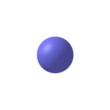Lithium cyanide
Toxic crystalline salt From Wikipedia, the free encyclopedia
Lithium cyanide is an inorganic compound with the chemical formula LiCN. It is a toxic, white coloured, hygroscopic, water-soluble salt that finds only niche uses.
 | |||
| |||
| Identifiers | |||
|---|---|---|---|
3D model (JSmol) |
|||
| ChemSpider | |||
| ECHA InfoCard | 100.017.554 | ||
| EC Number |
| ||
PubChem CID |
|||
| UN number | 1935 | ||
CompTox Dashboard (EPA) |
|||
| |||
| |||
| Properties | |||
| LiCN | |||
| Molar mass | 32.959 g/mol | ||
| Appearance | White Powder | ||
| Density | 1.073 g/cm3 (18 °C) | ||
| Melting point | 160 °C (320 °F; 433 K) Dark coloured | ||
| Boiling point | decomposes | ||
| Soluble | |||
Henry's law constant (kH) |
N/A | ||
| Structure | |||
| - | |||
| Fourfold | |||
| Hazards | |||
| GHS labelling:[4] | |||
   | |||
| Danger | |||
| H226, H300, H310, H330, H410 | |||
| P210, P233, P240, P241, P242, P243, P260, P262, P264, P270, P271, P273, P280, P284, P301+P310, P302+P350, P303+P361+P353, P304+P340, P310, P320, P321, P322, P330, P361, P363, P370+P378, P391, P403+P233, P403+P235, P405, P501 | |||
| NFPA 704 (fire diamond) | |||
| Flash point | 57 °C (135 °F; 330 K) | ||
| N/A | |||
| Safety data sheet (SDS) | 742899 | ||
| Related compounds | |||
Related compounds |
Sodium cyanide, Potassium cyanide, Hydrogen cyanide | ||
Except where otherwise noted, data are given for materials in their standard state (at 25 °C [77 °F], 100 kPa).
| |||
Preparation
LiCN is produced from the reaction of lithium hydroxide and hydrogen cyanide. A laboratory-scale preparation uses acetone cyanohydrin as a surrogate for HCN:[5]
- (CH3)2C(OH)CN + LiH → (CH3)2CO + LiCN + H2
Uses
The compound decomposes to cyanamide and carbon when heated to a temperature close to but below 600 °C. Acids react to give hydrogen cyanide.[6]
Lithium cyanide can be used as a reagent for organic compound cyanation.[7]
- RX + LiCN → RCN + LiX
References
Wikiwand - on
Seamless Wikipedia browsing. On steroids.



